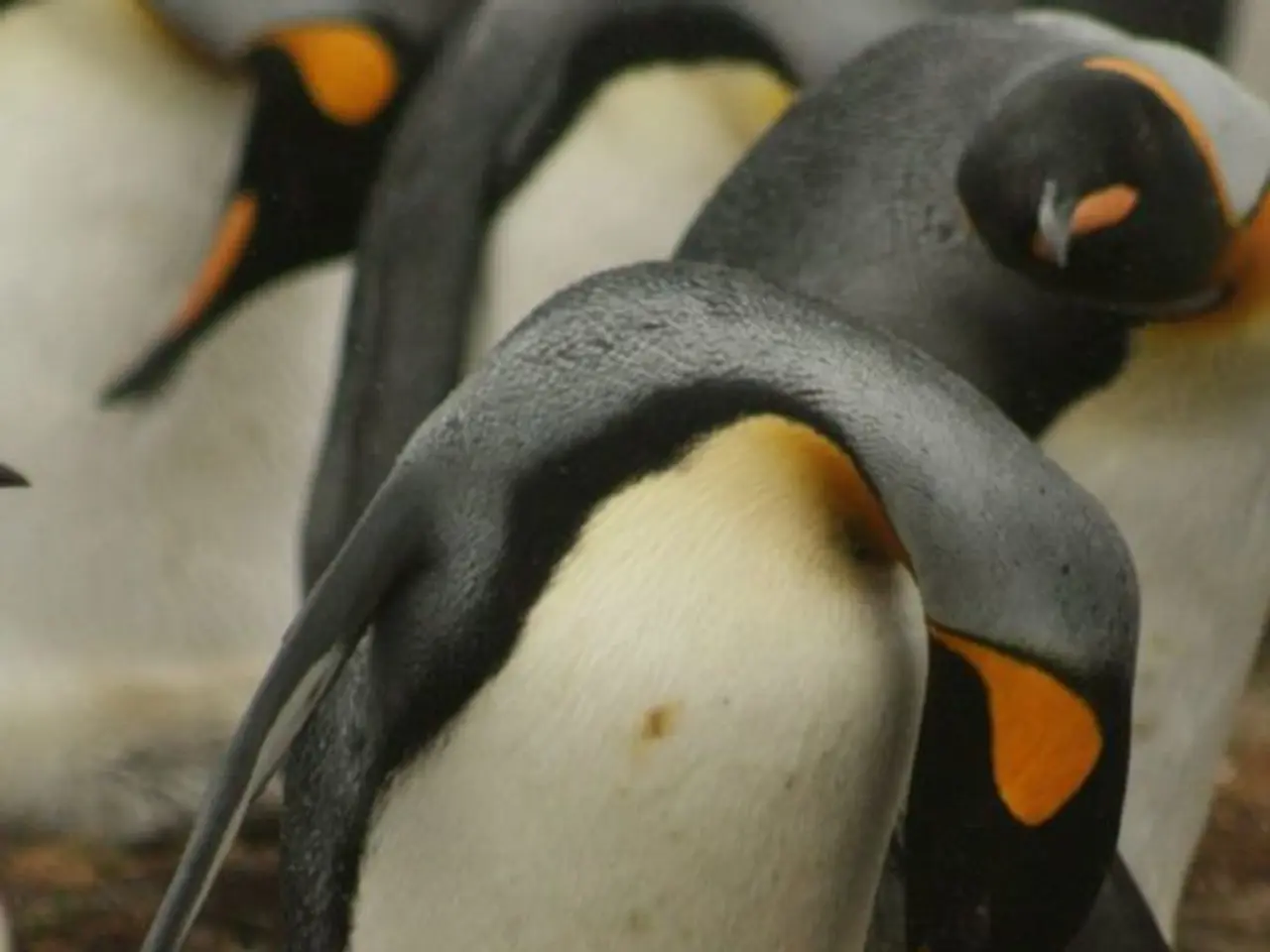Incredible traits of penguins: 14 facts showcasing the marvels of these aquatic birds, including their ability to jump, lay half-eggs, and never experience cold feet
=====================================================================
Penguins, those flightless birds famed for their waddling gait and distinctive black-and-white plumage, have developed a host of remarkable adaptations that enable them to thrive in some of the most challenging environments on Earth.
In the icy waters of Antarctica and the Southern Hemisphere, these avian marvels have honed their survival skills to perfection. Here are some of their key adaptations:
Physical Adaptations
The countershaded plumage of penguins is one of their most striking features. With their dark backs and white bellies, they blend seamlessly into both the sea and the sky, providing excellent camouflage while swimming and hunting. This plumage is also waterproof, thanks to oils produced by the penguin's body, which prevent water from penetrating the feathers and reaching the skin [1][2].
Another physical adaptation is the thick layer of fat underneath their skin, which insulates them from cold water and helps maintain body temperature. This fat layer can reach up to 3 cm in thickness, particularly important for emperor penguins before breeding [2].
Penguins also possess a special system called the humeral plexus in their flippers, which reduces heat loss by warming cold blood returning from the extremities with warm blood from the core body [1].
Behavioral Adaptations
Penguins often huddle together to conserve heat, especially during extreme weather conditions. They rotate positions to ensure each penguin gets a turn in the center of the huddle, maximising warmth for all members [2][3].
Social breeding and incubation behaviours are also common among penguins. Emperor penguins, for example, have males incubating eggs while females hunt for food. This division of labour allows them to survive the harsh Antarctic winter by sharing responsibilities and minimising individual exposure [2].
Behavioral and Physiological Adaptability
Penguins can control blood flow to their extremities, reducing the amount of blood exposed to cold temperatures but preventing frostbite by maintaining minimal flow. This adaptation helps in preventing their extremities from freezing [1].
Penguins' dietary adaptations are crucial for building fat reserves, essential for survival during lean periods. They feed on a variety of prey, including krill, fish, and squid, which are abundant in their aquatic environment [1][4].
Overcoming Obstacles
Despite their flightless nature, penguins are not limited to one location. Southern rockhopper penguins, for instance, have developed the ability to navigate treacherous rocky terrains with precision, similar to mountain goats.
The story of penguins isn't just about surviving in extreme conditions; it's about thriving there, finding opportunities where others see only obstacles.
Conservation Concerns
Unfortunately, multiple penguin species face declining populations due to climate change and human activity. The colony on the French island of Île aux Cochons once hosted over 2 million king penguins, but only 60,000 remain today due to a 90% population crash [5].
The macaroni penguin, the most numerous penguin species, despite facing rapid population decline, with approximately 12.6 million mature individuals [6].
Adélie and gentoo penguins can coexist in the same hunting grounds without destroying each other due to depth segregation in their hunting strategies [7].
Moseley's rockhopper penguin was officially recognised as a separate species in 2006 [8].
The world's smallest penguin species, the fairy penguin, weighs less than a bag of sugar and stands between 30-40 centimeters tall [9].
The Humboldt penguin thrives in the harsh conditions of the Humboldt Current along South America's western coast [10].
Penguins serve as marine ecosystem indicators, their population health reflecting the condition of Southern Hemisphere ocean systems [11].
The penguin story isn't just about surviving in extreme conditions; it's about thriving there, finding opportunities where others see only obstacles. However, it's crucial that we recognise the threats they face and work towards their conservation.
[1] National Geographic. (2019). Penguin adaptations. [online] Available at: https://www.nationalgeographic.org/animals/birds/p/penguin/
[2] BBC. (2020). Penguin adaptations. [online] Available at: https://www.bbc.com/bitesize/guides/z8q6r82/revision/1
[3] PBS. (2018). How do penguins keep warm? [online] Available at: https://www.pbs.org/wgbh/nova/article/how-do-penguins-keep-warm/
[4] Smithsonian Tropical Research Institute. (2020). Penguin diet. [online] Available at: https://www.stri.si/research/penguins/penguin-diet
[5] WWF. (2021). King penguin. [online] Available at: https://www.worldwildlife.org/species/king-penguin
[6] WWF. (2021). Macaroni penguin. [online] Available at: https://www.worldwildlife.org/species/macaroni-penguin
[7] WWF. (2021). Adelie penguin. [online] Available at: https://www.worldwildlife.org/species/adelie-penguin
[8] WWF. (2021). Rockhopper penguin. [online] Available at: https://www.worldwildlife.org/species/rockhopper-penguin
[9] WWF. (2021). Fairy penguin. [online] Available at: https://www.worldwildlife.org/species/fairy-penguin
[10] WWF. (2021). Humboldt penguin. [online] Available at: https://www.worldwildlife.org/species/humboldt-penguin
[11] WWF. (2021). Penguin populations as indicators of Southern Hemisphere ocean health. [online] Available at: https://www.worldwildlife.org/magazine/issues/summer-2020/features/penguin-populations-as-indicators-of-southern-hemisphere-ocean-health
- While penguins can't fly, they have developed remarkable physical and behavioral adaptations to navigate treacherous terrains, inspiring ideas in technology for robotic exploration and locomotion.
- In the world of fashion-and-beauty, designers draw inspiration from penguins' sleek profile and distinctive black-and-white coloration, using these elements in clothing, accessories, and makeup lines.
- Learning about penguins' survival strategies and adaptations can provide valuable insights for food-and-drink companies looking to improve their products' resilience and appeal in extreme environments.
- Weather forecasting agencies could potentially learn from penguins' ability to predict changes in the Southern Hemisphere's weather patterns, improving their accuracy and helping people prepare for extreme conditions.
- In the realm of entertainment, penguins' charming personalities have made them popular characters in books, movies, and TV shows, teaching children about perseverance, adaptability, and lifelong learning.
- Educational institutions offer courses on penguin behavior, physiology, and conservation, fostering learning about these amazing creatures alongside fields such as engineering, biology, and environmental studies.
- For sports enthusiasts, the precision and agility of Southern rockhopper penguins was the inspiration for a new style of tennis footwork, bringing a touch of penguin grace to the game.
- Sports-betting platforms have even developed odds on penguin-related events, such as predicting the first penguin to reach its nest during the harsh Antarctic winter, showcasing the captivating appeal of these animals and their remarkable abilities.




